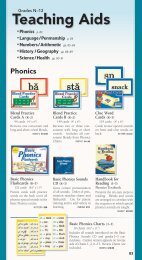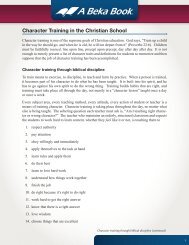Science & Health - A Beka Book
Science & Health - A Beka Book
Science & Health - A Beka Book
Create successful ePaper yourself
Turn your PDF publications into a flip-book with our unique Google optimized e-Paper software.
Physics cont.<br />
Current Generation—Electromagnetic Induction cont.<br />
• Discovery of electromagnetic induction:<br />
h Law of induction<br />
h Lenz’s law: direction of current<br />
• Electric generators:<br />
• Simple AC generators: armature, slip rings, brushes, alternating<br />
current, AC frequency<br />
• Simple DC generators: direct current, commutator<br />
h Complex generators: three-phase current<br />
• Motors:<br />
h Motor effect: electric motor, torque, torque arm, two-pole motor<br />
h Energy losses: hysteresis, eddy currents<br />
• Electrochemical cells:<br />
• Current production: electrodes, electrolyte, salt bridge, load,<br />
anode, cathode, electromotive force<br />
• Batteries: cells in series and in parallel<br />
• Thermoelectricity:<br />
h Seebeck effect: thermocouple, Seebeck voltage and effect<br />
h Peltier effect<br />
• Piezoelectricity:<br />
h Piezoelectric effect and devices<br />
Electric Circuits<br />
• Resistance:<br />
• Defining resistance<br />
h Resistance in a conductor<br />
h Ohmic, nonohmic, resistivity<br />
• Rheostat<br />
h Nichrome<br />
• Insulators, semiconductor, conductor, superconductivity<br />
• Ohm’s Law:<br />
• Elements of a circuit: current source, conventional current<br />
h Circuits with a single resistance: Ohm’s law<br />
• IR drop: voltage, energy transactions<br />
h Quantitative treatment of equivalent resistance:<br />
h Series and parallel resistors<br />
h Rules for resistances in series<br />
h Equivalent parallel resistance, rules for resistance in parallel<br />
• Complex circuits:<br />
• Networks<br />
• Circuit resistance and current:<br />
• Open circuit<br />
h Open-circuit voltage<br />
• Closed circuit<br />
h Closed-circuit voltage<br />
• Short circuit<br />
h Measuring electricity: multimeter, galvanometer, ammeter,<br />
voltmeter, ohmmeter<br />
h Kirchhoff’s Laws: first law, junctions, principle of charge conservation,<br />
second law<br />
Electrical Devices<br />
• Electrical work:<br />
• Work and heat:<br />
h Calculation of joule heat<br />
<strong>Science</strong><br />
188<br />
• Work and power:<br />
h red indicates NeW MATerIAL<br />
h Three equations for electric power<br />
• Energy consumption<br />
• Effective values of current and voltage: house current, in phase<br />
h Capacitor:<br />
h Calculating capacitance: farad, dielectric, dielectric constant,<br />
permittivity of free space, dielectric strength<br />
h Capacitor combinations: parallel and series capacitors<br />
h Inductance: single loop, self-induced emf, coil, self-inductance,<br />
inductor, mutual inductance<br />
h Inductor combinations: series and parallel inductors, series-aiding<br />
and series-opposing combinations<br />
• Transformers:<br />
h Transformer equation<br />
• Step-up and step-down transformers<br />
h Efficiency<br />
Advanced Physics Concepts<br />
• Quantum theory:<br />
• Blackbody radiation:<br />
• Incandescence<br />
h Stefan-Boltzmann law, Wien’s law<br />
• Quanta: Planck, quantum theory<br />
• Photons:<br />
• Photoelectric effect:<br />
h Photoelectrons, work function<br />
h Saturation potential, stopping potential<br />
h Threshold frequency, Eistein’s hypothesis, Compton effect<br />
• Matter waves:<br />
Grade 12<br />
h Momentum of light<br />
• De Broglie’s equation, matter waves<br />
h Wave-particle duality, complementarity<br />
• Quantum numbers:<br />
• Pauli exclusion principle, orbital<br />
• Principal, subshell, magnetic, and spin quantum numbers<br />
h Angular momentum<br />
• Spectral lines:<br />
• Line emission spectra:<br />
• Line absorption spectrum, emission spectra and classical<br />
theory, quantized, ground and excited states<br />
h Quantitative relationships between wavelength, energy, and<br />
quantum numbers<br />
• Wave mechanics:<br />
h Wave mechanical model, wave function<br />
• Uncertainty principle:<br />
h Mathematical formulation, philosophical implications<br />
Relativity<br />
• Speed of light:<br />
h Galileo’s, Rømer’s, and Michelson’s methods; ether, interferometer<br />
• Theories of relativity:<br />
h Physical absolutes, relativism:<br />
• Special relativity:<br />
• Five applications, rest mass, time dilation, length contraction<br />
h Quantitative aspects<br />
• General relativity: its effects, conclusion

















